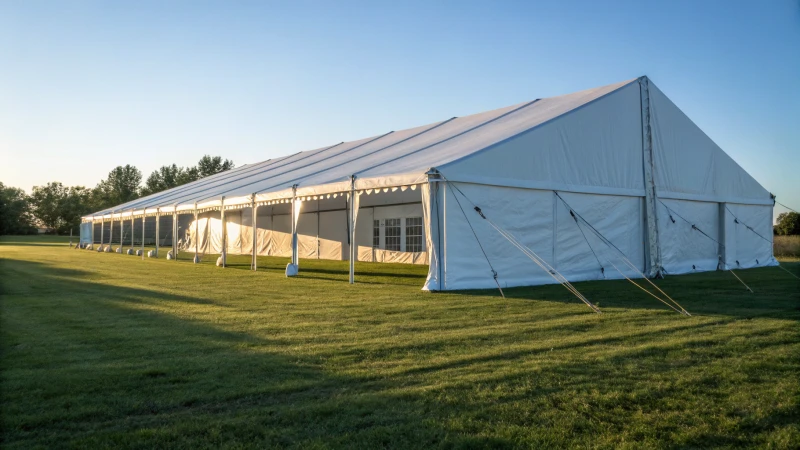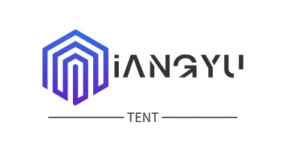
Ever thought about importing marquee tents from China but worried about finding a reliable supplier? Let me walk you through my journey to ensure quality and trust.
To find a reliable marquee tent supplier in China, I start by diving into platforms like Alibaba to check for verified manufacturers with great reviews. I always make sure they have the necessary certifications, request product samples, and engage in clear communication to match my quality and pricing needs.
I’ve learned that finding the right supplier is a bit like dating. You have to dig deeper beyond first impressions. While checking production capabilities and compliance standards, I also pay close attention to their customer service. This ensures that not only am I getting a quality product, but also reliable support whenever I need it. It’s all about building a relationship with a supplier who understands and meets my business needs. And just like any good relationship, communication is key. When suppliers are quick to respond and open to my questions, it feels reassuring—like finding the right partner in business.
Alibaba is the only platform to find tent suppliers.False
There are multiple platforms like Global Sources and Made-in-China.
Supplier communication skills affect sourcing success.True
Effective communication ensures clarity and prevents misunderstandings.
What Certifications Should a Reliable Tent Supplier Have?
Ever found yourself overwhelmed when choosing a tent supplier? I have, and trust me, certifications are the key to peace of mind.
Reliable tent suppliers should have certifications like ISO 9001 for quality management, CE marking for European safety compliance, and NFPA 701 or CPAI-84 for flame retardancy. These ensure high safety and quality standards.

Key Certifications to Look for in Tent Suppliers
ISO 9001: Quality Management
In my journey of sourcing tents, I’ve learned that ISO 9001 is more than just a certificate; it’s a promise. It’s like having a seal of approval that says, "Yes, this supplier values consistency and quality." Knowing a supplier meets these international standards gives me confidence that I won’t end up with tents that disappoint.
CE Marking: European Safety Compliance
When I first heard about CE marking, I thought it was just another bureaucratic hurdle. But then I realized it’s all about ensuring the products are safe, which means fewer headaches for me. If you’re eyeing the European market, this certification is a must-have to ensure that your tents can be legally marketed and trusted by customers1.
| Certification | Purpose | Region |
|---|---|---|
| ISO 9001 | Quality Management | Global |
| CE Marking | Safety Compliance | Europe |
| NFPA 701 | Flame Retardancy | North America |
| CPAI-84 | Flame Retardancy | North America |
NFPA 701 & CPAI-84: Flame Retardancy Standards
Safety is non-negotiable, especially when it comes to flame retardancy. The NFPA 701 and CPAI-84 standards are like my safety net, ensuring the tents I provide can stand up to rigorous flame resistance tests. For any event in the US, these are critical, and documentation from suppliers is essential to prove compliance with these standards2.
Additional Certifications: TUV, SGS, and More
Beyond the basics, certifications like TUV and SGS can further assure me of a supplier’s dedication to quality and safety. I remember being particularly impressed when a supplier showcased their SGS certification—it was like an added layer of trust. These certifications cover extensive product testing and verification processes across various industries3, giving me peace of mind that I’m investing in something worthwhile.
How to Verify Supplier Certifications
I’ve learned the hard way not to take anything at face value. Always request to see certification documents and verify them with the issuing bodies if possible. Platforms like Alibaba4 can be incredibly useful for checking the authenticity of these claims. Trust but verify is a mantra I live by when dealing with suppliers.
ISO 9001 is a global certification for quality management.True
ISO 9001 ensures suppliers meet international quality standards.
CE marking is required for tents sold in North America.False
CE marking is specific to European market safety compliance.
How Do You Verify a Supplier’s Production Capabilities?
Ever felt like you’re stepping into the unknown when verifying a supplier’s production capabilities? I sure have. It’s like piecing together a complex puzzle to ensure everything fits perfectly.
To verify a supplier’s production capabilities, I dive into their production capacity, scrutinize quality control processes, check certifications, and make sure to visit the facility—virtually or in person—to confirm they can meet my demands efficiently.

Assessing Production Capacity
I remember the first time I had to assess a supplier’s production capacity. It felt daunting, but asking about their maximum output levels and lead times for different order sizes was a great start. Ensuring they could handle custom orders5 or rush demands without sacrificing quality was crucial for me. This approach gave me confidence that they could keep up with my business needs.
Inspecting Quality Control Measures
Quality assurance is like the backbone of any production process. When I first started in procurement, I learned the hard way how vital it is to request documentation of quality control procedures. Ensuring compliance with ISO standards and inquiring about regular audits became second nature to me. A strong quality control process helps maintain consistency and reliability in product manufacturing6.
Reviewing Certifications and Compliance
I’ve found that certifications like CE, ISO, or SGS are not just papers but assurances of quality and safety. Asking for these documents helps me verify compliance and assess the legitimacy of a supplier’s production capabilities7. This step reassures me that I’m making a safe choice for my business.
Conducting Site Visits or Virtual Tours
Whenever possible, I love visiting a supplier’s production facilities. Observing operations firsthand ensures their processes align with my expectations. When travel isn’t an option, I’ve relied on virtual tours8, which still offer valuable insights into their manufacturing environment.
Utilizing External References and Reviews
Gathering feedback from existing clients provides additional assurance. I always request references from other businesses in my industry who have previously worked with the supplier. Positive testimonials reinforce the supplier’s credibility and ability to meet production requirements.
| Verification Aspect | Action Required |
|---|---|
| Production Capacity | Request detailed reports on max output levels and lead times |
| Quality Control | Verify quality assurance certifications and audit reports |
| Certifications | Ensure up-to-date international safety and quality certifications |
| Site Visits | Conduct physical or virtual tours of the facility |
| Client References | Collect testimonials from other clients |
By systematically verifying each aspect, I build a comprehensive understanding of a supplier’s true production capabilities, ensuring alignment with my business’s quality and delivery standards. This approach not only mitigates risks but also enhances the overall efficiency of my supply chain operations.
Site visits ensure accurate assessment of production capabilities.True
Visiting facilities provides firsthand insight into operations and capacity.
Certifications like ISO are irrelevant to quality control.False
ISO certifications are key indicators of adherence to quality standards.
Why Is Communication Key When Selecting a Supplier?
I still remember the first time a supplier left me hanging with a late delivery; it was a nightmare!
Communication with suppliers is crucial to ensure we’re all on the same page about expectations, quality standards, and delivery timelines. It’s how I build strong relationships, mitigate risks, and achieve procurement success.

The Role of Communication in Supplier Selection
I’ve learned over the years that effective communication is the backbone of any successful supplier relationship. It’s like having a good friend—you need to make sure you’re on the same wavelength about expectations, quality standards, and delivery timelines. One time, I assumed a supplier knew my quality standards without confirming it, and it nearly derailed a major project. Clear communication helps me avoid these potential risks9 like delays or quality issues that could really throw a wrench into the works.
Establishing Clear Expectations
When I kick off a new supplier relationship, communication is my number one tool for setting clear expectations right from the start. Whether we’re hashing out product specs, pricing structures, or delivery schedules, making sure we’re all on the same page is essential. I remember once I didn’t clarify customization needs early enough, and it led to costly errors later on. Here’s what I focus on:
| Expectation | Supplier’s Role |
|---|---|
| Quality Standards | Adhere to specified quality |
| Delivery Timelines | Meet agreed deadlines |
| Customization Needs | Provide tailored solutions |
Building Strong Relationships
Open lines of communication help me foster trust and transparency with my suppliers. I find that when suppliers feel engaged and informed, they’re more likely to prioritize my orders and offer flexibility10 in terms of pricing or customization. This relationship-building is something I’ve found to be integral to forming long-term partnerships.
Mitigating Supply Chain Risks
There was a time when a timely update from a supplier saved me from a logistical nightmare. Regular check-ins and feedback loops are now a staple in my operations, ensuring any potential issues are promptly addressed and operations keep flowing smoothly.
Enhancing Supply Chain Efficiency
I’ve found that efficient communication streamlines the entire supply chain process, reducing misunderstandings and errors. It’s all about smoother transactions and fewer disputes, which ultimately saves money for both parties involved.
In summary, communication isn’t just about exchanging information; it’s about creating a framework for successful collaboration. By prioritizing clear and consistent communication, I’ve managed to secure reliable suppliers who positively contribute to my business operations.
Clear communication reduces supplier delays.True
Effective communication helps align expectations, minimizing delays.
Misunderstandings have no impact on procurement.False
Misunderstandings can lead to costly errors and procurement issues.
Why Choose Small or Medium-Sized Suppliers?
Have you ever wondered why some businesses thrive with small suppliers?
Opting for small or medium-sized suppliers can lead to enhanced flexibility, personalized service, competitive pricing, and deeper relationships. These suppliers often deliver tailored solutions and quick responses, boosting your business’s adaptability and efficiency.

Flexibility and Responsiveness
In my experience, working with small and medium-sized suppliers has been like having an agile partner who dances to the rhythm of my business needs. They aren’t bogged down by the bureaucratic red tape that often entangles larger corporations. I remember a time when a last-minute change in demand had me panicking, but my supplier adjusted our order on the fly, ensuring we met the market without a hitch. This kind of flexibility means I’m not just keeping up with changes; I’m thriving because of them.
Personalized Service
There’s something truly comforting about knowing you can reach out directly to the decision-makers in your supplier’s company. With smaller suppliers, this isn’t just possible; it’s the norm. Once, I needed a very specific customization for a client event, and instead of getting lost in a sea of automated replies, I had a real conversation with someone who understood my vision. The result? A tailor-made solution that exceeded expectations and strengthened our business relationship11.
Competitive Pricing
Cost is always a big factor in any business decision, and this is where smaller suppliers often shine. I’ve found that their overheads are lower, which means they can pass on those savings to me. This was a game-changer when I was working with a tight budget but still needed high-quality products. It’s not about finding the cheapest option but about securing value that aligns with my financial goals.
| Benefit | Small/Medium Suppliers |
|---|---|
| Flexibility | High |
| Personalized Service | High |
| Competitive Pricing | High |
| Relationship Building | Strong |
Enhanced Innovation
I’ve noticed that smaller suppliers often bring an innovative edge to the table. They’re willing to experiment and embrace new technologies, providing fresh solutions that keep me ahead of the curve. This has led to some unique product offerings12 that set my business apart in a crowded market.
Closer Supplier Relationships
Building close relationships with suppliers has been one of the most rewarding aspects of my business journey. These partnerships foster open communication and collaboration, leading to effective problem-solving and mutual growth opportunities. Having a supplier who feels more like a partner than just another vendor can make all the difference in navigating challenges and seizing new opportunities together.
Small suppliers offer more personalized service.True
Smaller suppliers provide direct communication and tailored support.
Large suppliers are more flexible than small ones.False
Small suppliers adapt quickly due to less rigid structures.
Conclusion
Discover effective strategies for finding reliable marquee tent suppliers in China, focusing on certifications, communication, production capabilities, and the benefits of working with small to medium-sized manufacturers.
-
Understand why CE marking is essential for products sold in Europe. ↩
-
Discover the differences between these two flame retardancy standards. ↩
-
Explore what TUV certification involves and its significance in product safety. ↩
-
Find out how Alibaba ensures suppliers’ certifications are genuine. ↩
-
Explore this link to understand how suppliers handle custom orders without compromising quality. ↩
-
Learn about key quality control measures that ensure product consistency and reliability. ↩
-
Discover why international certifications are crucial for supplier credibility. ↩
-
Find out how virtual tours can provide insights into a supplier’s manufacturing processes. ↩
-
Explore techniques to manage supplier-related risks effectively, ensuring smoother procurement operations. ↩
-
Learn how flexible suppliers can adapt to changing needs, providing significant advantages in procurement. ↩
-
Explore how strong supplier relationships enhance business success through trust and collaboration. ↩
-
Discover how smaller suppliers’ innovative approaches can provide unique products and services. ↩








